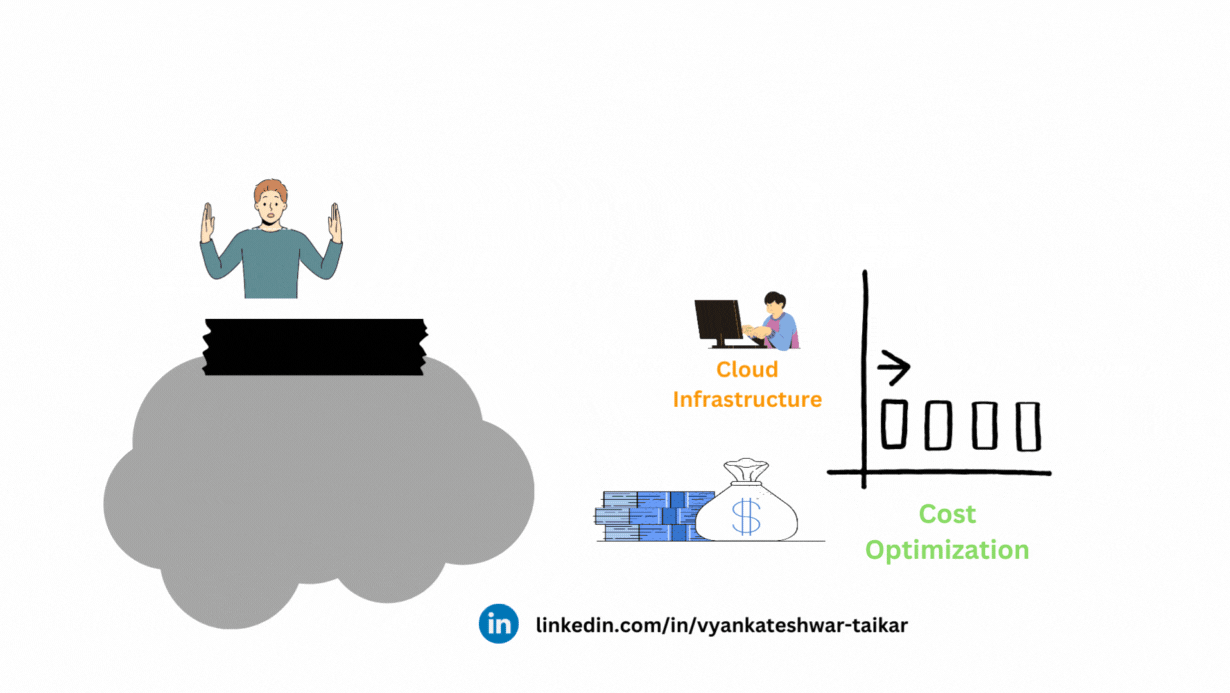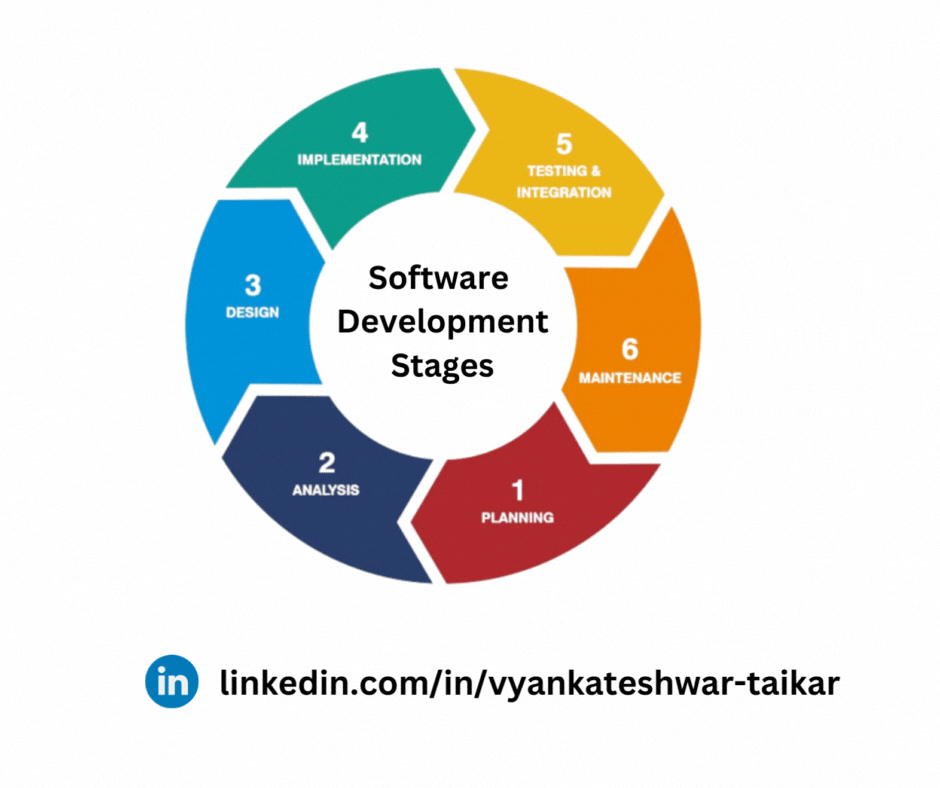💰8 Techniques For Cloud Cost Optimization💰
 Vyankateshwar Taikar
Vyankateshwar TaikarTable of contents
- 🌠Cloud Cost optimization: what is it?
- 🌠Why cloud cost optimization should be your top priority
- 🌠Best Practices & Techniques for Cloud Cost Optimization
- Identify Your Cloud Bill
- Identify & cut off and underutilized resources
- Make the right size choices for your computing services
- Research autoscaling with tools such as Kubernetes
- Choose the right storage solutions for the business you run
- Use spot instances
- Use metrics and real-time monitoring
- Minimize cloud expenses at every level of software development

🌠Cloud Cost optimization: what is it?
A strategic strategy to managing and reducing the costs related to your company's cloud computing services is cloud cost optimization. There are more than just cost-cutting strategies to optimize your cloud costs. Rather, they concentrate on conducting a thorough analysis of your present cloud usage, finding inefficiencies, and getting rid of unnecessary usage to get the most out of every dollar you spend on cloud resources.
Gaining more insight into the cloud infrastructure in order to make sure resources are used efficiently and to optimize cost with availability, security, and performance is the aim of cloud cost optimization.
🌠Why cloud cost optimization should be your top priority
or Why Cloud Optimization ?
Cost Efficiency
Reduce Budgets: By ensuring that you are receiving the most return on your cloud investment, cloud cost optimization enables you to more effectively deploy resources and cut down on wasteful spending.
Financial Sustainability
Long-Term Survival: Your organization's ability to remain financially stable is influenced by how well you manage cloud expenses. You may build a more robust and financially sustainable business model by minimizing overspending and maximizing resource utilization.
Resource Right-Sizing
Optimal Performance: Performance is enhanced and overprovisioning is avoided when resources are appropriately sized based on actual workloads. This prevents resource waste by only charging for the processing and storage capacity that you actually require.
Improve oversight and transparency
Increased transparency and oversight : Better visibility into where and how your cloud budget is being spent during cost reporting is made possible by the cloud cost optimization process. This greater understanding can help you connect your technology and business goals while increasing accountability.
Planning Strategically
Smart Budgeting: Improved strategic planning is made possible by comprehending and managing cloud expenses. You can make more precise budgets, distribute resources wisely, and match cloud spending to business goals when you have a clear picture of your spending.
Advantage of Competition
Resource Allocation: Businesses that successfully reduce their cloud expenses can use the money they save to fund research, innovation, or other important projects. This can give the company a competitive edge by enabling investments in growth-oriented areas.
Security and Compliance
Risk Protection: Excessive cloud expenses might result in dangers to finances and problems with compliance. Cost optimization is prioritized by putting security and compliance controls in place, which lowers the possibility of unforeseen costs and possible legal or regulatory issues.
🌠Best Practices & Techniques for Cloud Cost Optimization
( Note : Step by step implementation should be done )
Identify Your Cloud Bill
You can understand from following points :
a) Compute charges : They represent costs for the computing power expended. The sizes and types of virtual machines you are running will determine this price. Regional variations, the use of spot instances, or reserved versus on-demand instances may all affect prices.
b) Costs associated with managed services : There are fees associated with using managed services (like managed databases), which are billed on an hourly or use basis.
c) Storage expenses : These fees are incurred when data is stored on cloud servers. Your overall storage costs can be affected by various storage types (such as object and block), redundancy options, and fees for data retrieval and transmission.
d) Bandwidth costs : The quantity of data that is transmitted to and from your cloud server over a specific time frame, like a month, is known as bandwidth.
In terms of cost: These fees, also referred to as "egress costs," cover data that enters and exits your cloud environment. These expenses, which might differ significantly from month to month if your company uses a lot of bandwidth, also take into account data transfers within and between regions as well as data transfers between your cloud and the internet.
e) Support Cost & Discounts and savings :
Your plan and cloud provider may have different prices for different support tiers.
The total amount of your account will be reduced by any advance payments, reserved instances, committed use contracts, or other discount programs in which your business is involved.
Identify & cut off and underutilized resources
Identifying underutilized (and poorly used) cloud resources should be a part of your cloud cost optimization plan. These underutilized resources may appear harmless, yet they can slowly eat away at your budget and add little value to your company.
The following are some preventive steps you can follow:
a) Create regular monitoring setup : Utilize cloud monitoring solutions with alert notifications to keep an eye on resource utilization on a regular basis. Track important metrics like CPU, disk, disk I/O, bandwidth, and memory usage. Resources that are regularly unused, or idle resources, have to be considered for reduction or elimination.
b) Find relevant cloud resources: Look out for situations where there is little to no activity for a long time. For example, over several months, there might not be any substantial read or write operations in an idle database. These are the most appropriate things to remove.
c ) Analyze and work on action : Determine which resources are underutilized and then evaluate their future necessity. Choose to eliminate or reduce them if they won't have an impact on your ongoing business operations or future projects.
Make the right size choices for your computing services
Here are some useful pointers for appropriately scaling your cloud computing services:
a) Recognize the amount of work you have : Take some time to evaluate your workloads, taking into account usage trends and performance requirements. This information will provide you the background you need to make the most optimal use of your computer resources.
b ) Make use of heatmaps : Heatmaps give you a visual picture of the computing demand of your business over time. Through pattern recognition and heatmap monitoring, you may pinpoint cost centers and reallocate resources accordingly.
c ) Explore multiple configurations : Try out different instance types and sizes to see which works best for each job. This will guarantee that you identify the ideal setup.
d ) Use load balancing into practice : By distributing workloads across resources equally, load balancing helps avoid both overuse and underuse. This can help make sure you're not overpaying for capacity that isn't being used and that you're utilizing computer resources as efficiently as possible.
e) Review and modify regularly : Correct sizing is an ongoing process. There are significant long-term cost benefits to be gained from routinely assessing your resources and scaling adjustments in response to changes in workloads.
Research autoscaling with tools such as Kubernetes
One major benefit of creating a cloud-first business model is the ability to scale on demand. But manually controlling scalability can be difficult, which might result in over-provisioning and higher expenses. One way to provide effective resource efficiency and cost savings is through autoscaling.
By using AutoScaling , you may dynamically change the amount of computing power according to real use. For workloads that are unexpected and mission-critical, autoscaling is especially helpful. Autoscaling makes ensuring that you utilize the correct amount at the right time possible, as opposed to letting resources idle during low usage or reaching capacity during high usage.
Kubernetes, an open-source container orchestration system well-known for its capacity to automate application deployment, scaling, and management, is an excellent solution for allowing autoscaling. Several options are available in Kubernetes to enable efficient autoscaling:
Autoscaler Cluster (CA), HPA or Horizontal Pod Autoscaler Autoscaler & Vertical Pod (VPA).
Choose the right storage solutions for the business you run
The following tips will help you maximize your cloud storage:
a) Make the correct storage type choice : Within block and object storage, the majority of cloud providers provide different storage classes, spanning from high-performance to low-cost tiers. Select the option that best suits the frequency of access and performance needs of your data.
b) Make use of lifecycle management methods: With the help of lifecycle management, you can set up rules that gradually transfer rarely used data to cheaper storage tiers or archive it. This strategy might prove to be economical.
c) Review and clear your storage on a regular basis: Don't forget to routinely check your storage and remove unnecessary or out-of-date data. This can involve out-of-date backups, unutilized snapshots, or obsolete data that is no longer useful for business.
Use spot instances
Unlike on-demand instances, spot instances let you bargain on unused cloud provider capacity at an important discount. For workloads that are flexible and non-critical, these instances can be a good way to cut costs even though the provider can interrupt or reclaim them. Spot instances can be an affordable component of your cloud cost optimization strategy if they are managed properly.
To make the most of spot instances, follow these tips:
a) Continually check the costs of spot instances: Prices at the spot are subject to change due to supply and demand. Utilize third-party resources to keep an eye on pricing trends and assist you in making wise purchases.
b) Choose the appropriate spot instance use case : For stateless applications, development and test environments, and other workloads that can be stopped without causing significant harm, think about utilizing spot instances.
c ) Spot instances should be integrated with load balancers: By connecting your load balancers to your spot instances, you can minimize the impact of any disruption to one spot instance and guarantee that your burden is dispersed equally.
d ) Maintain a backup plan : Having a backup plan in place for when a spot instance is reclaimed is essential. This might include transitioning to on-demand instances automatically.
Use metrics and real-time monitoring
a) CPU utilization. You can spot underutilized instances by keeping an eye on CPU consumption, which could indicate that you're paying too much for capacity that isn't being used. On the other hand, identifying instances that are overutilized can indicate the necessity of scaling up.
b) Storage usage Make sure you aren't paying for extra storage by keeping an eye on how much you use. Eliminate superfluous or out-of-date data on a regular basis to keep storage expenses from rising.
c) Memory utilization. You can determine whether your instances are the right size for your workloads by routinely looking over your memory usage.
d) Network traffic. Increased network traffic may be an indication of a busy instance and result in high data transfer expenses. Keeping an eye on this metric may help with managing data transfer costs.
e) Error rate : A high error rate may be a sign of an issue that could drive up expenses, like more CPU consumption to handle exceptions or increased network traffic from reloads.
f )Track Instance uptime & take action on it : Monitoring uptime makes it easier to spot instances that aren't being used and shut them down. You can save money by shutting down instances that, for instance, are only used during business hours but are running constantly.
Minimize cloud expenses at every level of software development

a) Planning : Determine the cloud resources you'll require for development initiatives and project your needs. Utilize past data to forecast usage trends and choose the resources that will serve your needs the best at the lowest cost.
b) Development : For testing and development purposes, use smaller and chapter instances. Develop with the intention of producing scalable, light-weight applications while keeping cost-effectiveness in mind.
c) Testing : To expedite this step and cut down on resource consumption time, use automated testing. Spot instances should also be taken into account for non-critical testing settings. After testing, remove temporary resources to save money.
d) Deployment : Automate deployment procedures to cut down on errors and resource utilization time, much like you would with testing.
e) Monitoring : set up real-time monitoring and use Slack-like services to put up warnings for anomalous resource consumption. Employ load balancing to effectively distribute traffic and auto-scaling to adjust to changing demands.
f) Maintenance : Set up time to periodically examine your resources and applications and remove those that are no longer required.
g) Updates: Test your updated software on smaller instances. By doing this, the expense of mistakes on larger, more costly production instances may be reduced.
I hope you enjoy the blog post !
If you do, please show your support by giving it a like ❤, leaving a comment 💬, and spreading the word 📢 to your friends and colleagues 😊
Subscribe to my newsletter
Read articles from Vyankateshwar Taikar directly inside your inbox. Subscribe to the newsletter, and don't miss out.
Written by

Vyankateshwar Taikar
Vyankateshwar Taikar
Hi i am Vyankateshwar , I have a strong history of spearheading transformative projects that have a direct impact on an organization's bottom line as a DevOps Engineer with AWS DevOps tools implementations.